PinotFile: 6.47 December 3, 2007
|
Fort Ross: Growing Pinot On the EdgeGrowing Pinot Noir along the most western reaches of the Sonoma Coast might be regarded as pure folly to many, but the dedicated band of winegrowers who have accepted the challenge know that the fickle grape feels right at home here. This region is quickly becoming one of the epicenters of fine Pinot Noir in California. 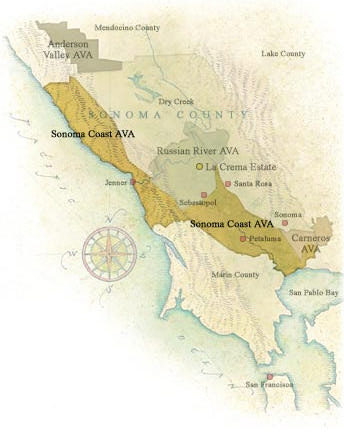 The Sonoma Coast AVA is the largest of the 13 AVAs in Sonoma County at 750 square miles. This cumbersome AVA was formed in 1987 primarily to allow certain wineries to include all of their scattered major vineyards within one boundary so they could use the “estate bottled” designation on their wine labels. The Sonoma Coast AVA is defined by its coolness, with no more than 2,800 degree days of heat during the growing season. It is sandwiched between the mountains and the Pacific Ocean, and with its high winds, daily fog, and cold temperatures, is a hostile environment only Pinot Noir could love. The vineyards are situated primarily above the fog line or in lower reaches where the wind blows off the fog. There are an endless number of microclimates and soil types in the Sonoma Coast AVA, but the common denominator is the area’s coolness. The Sonoma Coast AVA extends from the Sonoma County border with Napa in Carneros to the east, to Marin County to the south, to the Pacific Ocean to the west, and to the Russian River Valley AVA boundary to the north. It overlaps five other AVAs including the Sonoma part of Carneros, a sliver of Sonoma Valley, the western part of Chalk Hill, all of Green Valley, and most of the Russian River Valley. Although the AVA is 517,000 acres and almost half the size of Sonoma County, only 7,000 acres are planted to vineyards. Fifty growers and six wineries are located within the AVA’s borders. Because of the unwieldy immensity of the Sonoma Coast AVA, a portion has been unofficially divided into the “true” Sonoma Coast. This subdivision is roughly from Jenner in the south where the Russian River empties into the Pacific Ocean to Annapolis in the north and from the beaches of the Pacific Ocean to 5-6 miles inland including the first two ridges of the Coastal Range of mountains and the western slope of the third ridge. Besides Annapolis and Jenner, Occidental and Freestone are usually included, although both are south of Jenner. 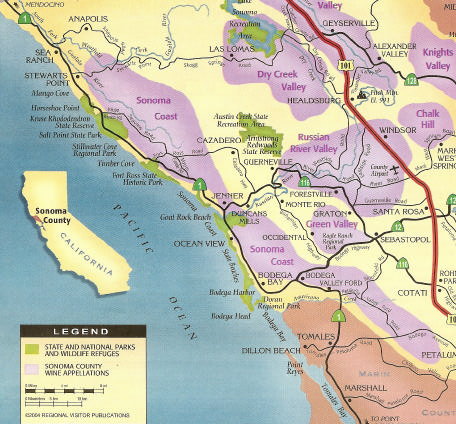 Fort Ross was established in 1812 by the Russian-American Company. In 1817, grapevines were brought from Peru and planted on a hillside near Fort Ross. These plantings predate others to follow in Napa and Sonoma counties. The area became known for logging and ranching, and it wasn’t until the later 20th century that grapes were reintroduced in any significant amounts. Mike Bohan was the first person in the modern era to plant grapes in the true Sonoma coast. In 1973, he developed a vineyard on Bohan Dillon Road which included Zinfandel, Pinot Noir, Chardonnay and Riesling. David Hirsch was another visionary who came to the area shortly thereafter. In 1978, he has become synonymous with the true Sonoma Coast. The list of subsequent pioneers in the true Sonoma Coast reads like a who’s who of California Pinot Noir. The names include Helen Turley and John Wetlaufer (Marcassin), Lee Martinelli (Martinelli), Bill Smith (W.H. Smith), Ted Lemon (Littorai), Walt and Joan Flowers (Flowers), Mark Bixler and Steve Kistler (Kistler Vineyards), and Daniel and Marian Schoenfield (Wild Hog). More recently, there has been considerable investment in the true Sonoma Coast by several prominent Napa wineries including Caymus (Belle Glos), Pahlmeyer, Peter Michael, Benziger, and Joseph Phelps. Lester and Linda Schwartz came to the true Sonoma Coast from an unlikely location, South Africa. While students at the University of Cape Town in the 1960s, they met and shared their love for food and wine. They married in 1967, and emigrated to the United States nine years later, settling in the San Francisco Bay Area. Lester longed for the country life he grew up with in South Africa and located a remote property in the high coastal ridges near the Pacific Ocean, just south of the small town of Fort Ross. He and Linda purchased the property, built an unusual house offering dramatic views of the surrounding countryside, and planted a vineyard. Linda studied viticulture at Santa Rosa Junior College and took classes at University of California Davis. Although her background was in music composition, she had an affinity for working the soil and operating farm equipment. Lester and Linda, along with a small crew, began in 1994 to develop their 44- acre vineyard. They installed a sub-surface drainage system and miles of fencing to keep out the deer and wild boar. Preliminary plantings with a test vineyard indicated the area was ideal for growing Pinot Noir and Chardonnay. The vineyard is less than a mile from the Pacific Ocean, and is one of the closest, if not the closest vineyard to the ocean in all of coastal California. A total of 28 vineyard blocks ranging in size from one-half to two acres are planted in heterogeneous microclimates scattered over the ridge tops at 1200 to 1700 feet. Pinot Noir plantings included field selections of Calera, Pommard, Swan and Dijon clones 115 and 777. 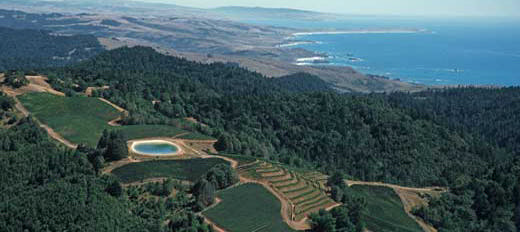 One of the unique features of the Fort Ross vineyard is the plantings of Pinotage. Lester and Linda had fond memories of Pinotage from their early years in South Africa. They sourced bud wood from two of the best blocks in South Africa and were the first private growers to bring these cuttings through the Foundation Plant Services that operates in conjunction with the University of California Davis School of Viticulture and Enology. Pinotage was originally bred in South Africa in 1925 at Stellenbosch University by Professor Perold who crossed Pinot Noir and Cinsaut (often called Hermitage in South Africa, the source of the name is confusing as Cinsaut is neither grown in the Rhone or included in Hermitage wine). At first, it was enthusiastically touted as having the flavors of Pinot Noir with the high yields and easy ripening of Cinsaut. However, it never offered the alluring flavors of Pinot Noir or even the taste of Cinsaut. In spite of this, Pinotage did develop a following and with appropriate low-yields and handling in the winery, it can be an original wine of interesting charm and distinctive flavors unlike any other varietal. When young it is said to taste like Gamay Beaujolais, as it matures it resembles a Rhone wine, and in maturity has the characteristics of a well-aged Bordeaux wine. The Schwartzes have had success with Pinotage, and theirs is one of the best examples in the world. For more information on Pinotage, consult the Pinotage Association’s website, www.pinotage.co.za. The inaugural vintage for Fort Ross Vineyard was 2001. Fred Scherrer (Scherrer Winery) was the initial winemaker. Ed Kurtzman (formerly Bernardus, Chalone and Testarossa, currently Freeman and August West) started with Fort Ross in 2003. He made all of the wines in 2003 except for the Reserve Pinot Noir, which Fred crafted, and has continued to the present as the sole winemaker. Ed hails from Boston, Massachusetts, where he majored in history and sociology while attending the University of Massachusetts. While in college, he worked in a wine shop and subsequently moved to California to sell wine in the Bay Area. He quickly realized that he would rather make wine than sell it, and attended Fresno State to obtain his degree in enology. The Schwartzes feel very fortunate to have Ed and his 17 years of winemaking experience with cool climate varietals. Ed told me that his goal at Fort Ross is not to shoot for a certain style, but rather let the vineyard do the talking. He has found the vineyard produces wines with notable tannin, in excess of what he is used to working with. When I tasted through several Fort Ross Pinot Noirs recently, I found the flavors more expressive than the aromatics. The reason, Ed says, is that more tannic fruit needs additional time for the aromatics to come alive. The 2004 and 2006 vintages are probably the ones that have hit their stride earlier than other vintages in this regard. 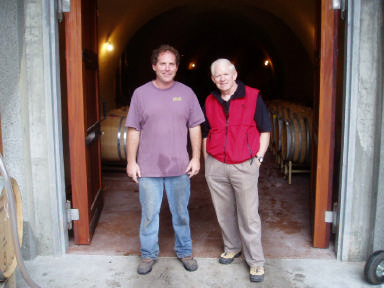 2006 Southern Right Cellars South Africa Pinotage 14.0% alc., $19. Imported by Vineyard Brands Inc., Birmingham, Alabama. Grown in Walker Bay close to the south Atlantic Ocean and named after the rare Southern Right whale which visits Walker Bay each year. I thought it would be interesting to sample a South African Pinotage side-by-side with the Fort Ross Pinotage. Selections of Pinotage in retail wine stores is quite limited and I may not have chosen an appropriate bottle to compare. · This wine was dark violet in color with an unpleasant nose of burnt wood. Stalky, woody and a bit sour with a dry finish, there was no fruit to be found. This was an unpleasant wine to drink. Perhaps it had an unfortunate experience on its trip to the States.
2005 Fort Ross Vineyard Reserve Sonoma Coast Pinot Noir 14.0% alc., 500 cases, $60. A barrel selection of the property’s finest wine. Not released on winery’s website for sale but obtained thru a retail source. · This is a spirited wine showing black cherry fruit with a touch of Asian spice and oak. The aromatics are unyielding and the wine needs time to shed its tannins. This is a debutante waiting in the wings to come out. A few years in the cellar will highly reward the patient drinker.
 2004 Fort Ross Vineyard Sonoma Coast Pinot Noir 14.5% alc., 917 cases, $39. A year with light berry set. Some blocks only produced a half ton per acre. Harvest was mid to late September. Aged 11 months in 45% new French oak. Pommard, Swan, Dijon 115, 777 clones. · A nondescript perfume with a hint of strawberry and peppermint. Understated with light-weight fruit. Soft, elegant and nicely balanced.
2004 Fort Ross Vineyard Reserve Sonoma Coast Pinot Noir 14.5% alc., 370 cases, $49. Calera and Dijon 115 clones. Aged 11 months in 50% new French oak. · This wine’s aromatics are a little more expressive with darker fruits, cola and sawdust. The blue and black Pinot fruits are nicely spiced. Soft and pillowy, the balance is right on. This beauty is deserving of the Reserve designation and among the wines tasted, showing the most leg at this time. Queen of the Hop.
2003 Fort Ross Vineyard Sonoma Coast Pinotage 14.7% alc., 400 cases, $32. Pinotage is vinified in a similar fashion as Pinot Noir. After a cold soak and fermentation in open-top fermenters, the wine is pressed and aged in primarily one-year-old French oak for 15 months. It is estate grown from proprietary Pinotage clones and is bottled unfined and unfiltered. · A very complex nose featuring cherry, cranberry, iodine, spearmint, wax and even fresh paint. Luscious hi-tone black raspberry fruit with a hint of spice. Velvety in texture with ripe, suave tannins. Excellent!
2003 Fort Ross Vineyard Symposium Sonoma Coast Pinot Noir 14.7% alc., 688 cases, $32. 96% Pinot Noir and 4% Pinotage. Aged 16 months in 50% new French oak. · An earth-based nose with moodier and darker fruits. A little pepper and farmyard adds interest. Delicious flavors of cherry pie, nutmeg, strawberries and cookie dough. Nicely balanced with an appropriate acid backbone.
2001 Fort Ross Vineyard Reserve Sonoma Coast Pinot Noir 14.5% alc., 112 cases. Individual blocks were harvested on multiple occasions based upon flavor profile and ripeness of each vine. Yields were low. The clones and different vineyard blocks were kept separate during winemaking. The final blend was chosen from barrels which had distinctive fruit concentration, complexity and balance. Aged 18 months in 60% new French oak. · Lightest in color of the wines tasted with a slight auburn cast to rim. Initially the nose was subtle but seductive with cherries and fresh-sawed oak. Over time, the aromas came alive with savory cherry and spice enhanced by old wood and leather charm. Red cherry flavors were soft and light. The fruit has faded a bit, but I liked this wine for its finesse. Drink up.
There are several unifying traits noted in the Fort Ross Vineyard wines. The wines consistently exhibit very admirable balance. The style is understated and elegant. The aromatics can be quite shy and may benefit from decanting and/or further aging. The flavors are more showy and alluring. Tasting through this series of wines reconfirmed by continuing impression that you must give Pinot Noir time to open up! Looking at all of the additions and deletions in my notes, it is clear that Pinot Noir is a chameleon, always changing in the glass. The problem with tasting notes is that they often reflect a small window in time. This is why I taste wines over at least an hour time period. The aromatic and flavor profiles will often pick up interest and complexity over this time. If the wine is still unyielding, I will decant or taste from the opened bottle the next day. Be patient and you will often be surprised! Fort Ross Vineyard sales office is 550 Indiana St, San Francisco, CA. The wines are available on the website at www.FortRossVineyard.com. Vintages dating back to 2002 can be purchased from the winery’s library. The phone is 415-701-9200. There is also an excellent Chardonnay and Rosé available for sale. 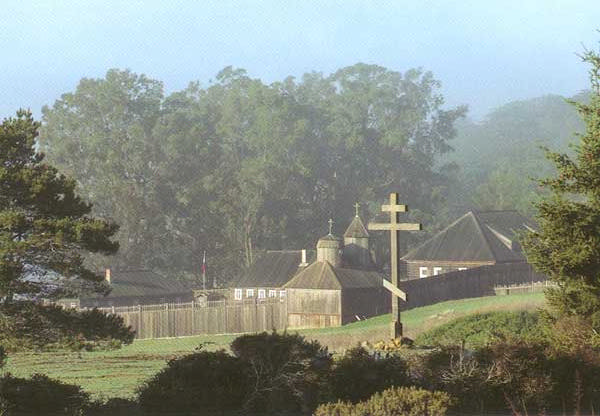
Clos Saron: Artisan WinesThe Sierra Foothills is not a region that comes to mind when you think about sources of California Pinot Noir. However, this appellation has a history with Pinot Noir dating back to the 1880s. According to John Winthrop Haeger (North American Pinot Noir), Eugene Hilgard of the University of California directed the planting of experimental vineyards in the foothills of the Sierra Nevada near the town of Jackson in Amador County. More than 150 varietals including Pinot Noir were planted. The Jackson station was closed in 1903 as the experiment proved untenable. Some surviving Pinot Noir vines were discovered in 1963 and the so-called Jackson clones remained of interest , presumably because they exhibited some resistance to cold, having become adapted to frigid winters in the Sierra Nevada. University of California Davis classified them as UCD 1, UCD 9, UCD 16 and UCD 29. The Jackson clones were never widely planted. According to Haeger, “The Jackson clones have the distinction of being the earliest documented imports of Pinot Noir still under cultivation in North America, having unarguably been imported before 1890 - and perhaps considerably earlier.” The Sierra Foothills appellation is a sprawling AVA of 2.6 million acres that includes Amador, El Dorado, Nevada, Placer, Calaveras, Tuolumne, Mariposa, and Yuba counties. The AVA is characterized by hot days and very cool nights, the range depending on the elevation. There are now well over 100 wineries that call the Sierra Foothills home and the area has developed a deserved reputation for hearty Zinfandel.  Gideon Bienstock and wife Saron Rice have developed a very small and young vineyard in the northern limits of the Sierra Foothills AVA. Gideon has over 28 years of experience in the wine industry as buyer, seller, educator, writer and winemaker (he is also the winemaker for the famed and nearby Renaissance Vineyard & Winery) and Saron has considerable knowledge of viticulture. Together, they have set a goal to transcend all of the preconceived notions that exist about what winegrowing possibilities exist in this region. What they have started, and what they have accomplished to date, is highly unusual from just about every point of view. They only work with organic fruit and farm all of their grapes, including sourced grapes, themselves. They specialize in Pinot Noir and non-traditional blends of other red and white varietals. Winemaking is pure and simple - no acid corrections, no fining or filtration, no inoculations, no racking and very minimal sulfur dioxide additions during barrel aging. The barrels are sourced from the Rousseau family in Gevrey-Chambertain, the wine is aged on its lees for as long as necessary, often until the day of bottling. The wine is then bottled manually, direct from barrel. Each bottle is numbered. Not surprisingly, the result is highly unique wines available in very limited quantities and consistently high in quality. One-of-a-kind to be sure.
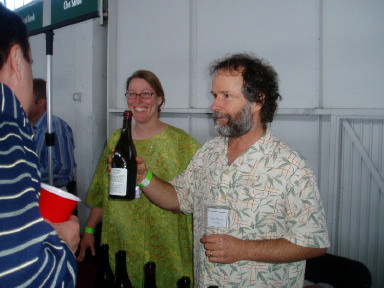
Gideon notes that harvest is done over 3-4 weeks, with repeated passes through the vines, picking only perfectly ripe fruit (perfectly ripe is determined by the grapes’ color, stem and seed maturation and a very slight softness to the touch of the grapes). The grapes are destemmed and fermentation follows in open-top fermenters lasting anywhere from 4 to 14 days. The wine is pressed at dryness very gently, directly into barrels, about 50-100% new. Aging is typically 13-16 months, at which time the wine is racked off the lees by compressed nitrogen into a blending container and bottled manually by gravity. The result is a Clos Saron Home Vineyard Pinot Noir and Clos Saron Pinot Too (from young Home Vineyard vines and sourced fruit) that are very uniquely expressive of this region. The wines in no way duplicate that of any other California Pinot Noir. They are not especially suited for comparative tastings, but best enjoyed at the dinner table, where they interact with food. Their tannins are easily neutralized and harmonized by the proper table companions. Gideon says, “I like to think that they offer a respectable alternative for those whose palates get overwhelmed and tired of the superalcoholic, super-rich, and super-thick. The wines are for those who keep tasting and following what is happening in their glass past the first couple of sips and throughout dinner.” Personally, I find Clos Saron Pinot Noirs highly distinctive and among the most, dare I say, “Burgundian,” Pinot Noirs in California with an emphasis not on flashy fruit, but on gamy, earthy, mushroom, mineral and barnyard highlights, along with a healthy tannic structure that bodes well for aging. It takes a real Pinot Noir connoisseur to appreciate these wines. 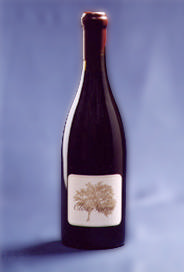 Gideon describes his Home Vineyard Pinot Noir as follows. “Tends to be structured, spicy, minerally and earthy, with strong vintage variation in terms of balance and expression. It tends to age slowly and improve over time in terms of texture, refinement, harmony and added flavor complexity. In my view, only the 2000 vintage is sort-of fully mature. With the exception of that vintage, earlier vintages were more structured than more recent ones. To this point, none of the aging wines have developed symptoms of over-the-hillness, and to my mind, this indicates that this terroir produces long-lived Pinot Noirs by California standards, reaching maturity at 8-12(?) years in the bottle.” With regards to his Pinot Too Pinot Noir he comments. “In 2002 and 2003, the young vines started producing very limited quantities of grapes. I did not want to blend these with the older vine fruit and chose to buy some grapes from the nearby Renaissance vineyard. This blend was named “Pinot Too” and the older vine Pinot Noir became the “Home Vineyard “ (the 1999-2001 vintages were simply labeled Clos Saron Pinot Noir). The Pinot Too proved to be fruitier and earlier maturing than the Home Vineyard version of the same vintages. Beginning with the 2004 vintage, I found the quality and character of the young vine fruit to be “worthy” of being blended with the older vine grapes to produce the Home Vineyard Pinot Noir.”
2004 Clos Saron Home Vineyard Sierra Foothills Pinot Noir 13.3%, 47 cases, $45. This year Gideon said was his experiment with joining the “ripeness is all” crowd. He waited longer for more physiological ripeness than ever before or since. Water had to be added to the must. “In retrospect, I think it did not turn out too bad, but I feel that we went further in that direction than I would ever go again. In my perception, the very hint of over-ripeness, which this wine does show to my palate, compromises the typicity and terroir expression, which are the wine’s soul. That said, I have been told by many that this is their favorite vintage of ours.” · I have to admit, I liked this wine very much too. The aromatics are terrific with plenty of barnyard, mushroom and minerality. The flavors are subtle and alluring with luscious strawberry and cherry fruit. Just the right mix of fruit and earthiness. No over-ripeness evident. The tannins are well-concealed and the whole package is nicely balanced. Makes you want to clap your hands.
2003 Clos Saron Pinot Too Sierra Foothills Pinot Noir 13.2% alc., 56 cases, $30. · This is a “tannic mutha’.” Heady spiced and confected cherries with a floral note that composes the attractive aromatics. The masculine Pinot extract is currently obscured by oak. This wine needs cheese or hearty food.
2003 Clos Saron Home Vineyard California Pinot Noir 13.3% alc., 31 cases, $45. · Moderate reddish-purple color in the glass. The fruit plays second fiddle to the aromas and flavors of loamy earthy, smoke, tobacco and ash. There is plenty of drying tannins and a bright acid spine. A rustic wine with plenty of heft and a prominent smoky tone throughout. Decent.
2003 Clos Saron Home Vineyard Sierra Foothills Pinot Noir 13.3% alc., 32 cases, $45. Ripening was more even in this vintage. There was Botrytis pressure for the first time. Once again, Gideon and Saron were removing individual defective grapes from otherwise beautifully ripe clusters. The wine seemed similar to the 1999 vintage when bottled showing a powerful presence. Unlike the 1999, there was a distinctive chocolate aftertaste early on. · Very dark ruby in color. Barnyard and mushroom scents dominate. Woody tart cherry flavors with noteworthy drying tannins on the finish yet to be shed. Muscular but not harsh. Needs further time in the cellar.
2002 Clos Saron Pinot Too Sierra Foothills Pinot Noir 13.2% alc., 29 cases, $25. Another frost damage year. In a larger vineyard, 2002 would have been a disastrous vintage, due to a combination of both unripe and over-ripe grapes in the same clusters. Hours were spent painstakingly removing every under-ripe and over-ripe grape from every cluster in order to crush only perfectly even, ripe fruit. · Rather restrained aromatics with deep, dark fruits, a hint of oak, cardamom, ripe tomato and char. Redder fruits peak through in the finish, particularly candied cherry. Tannins are reigned in. A very easy drink now and thoroughly enjoyable.
2001 Clos Saron Sierra Foothills Pinot Noir 13.0% alc., 28 cases, $45. A very structured and concentrated vintage with yields reduced by extensive frost damage. A notable spice dimension at the finish has distinguished this vintage. · Aromas of crushed dark cherries, cassis, game, pepper, barnyard and a hint of oak spice lead off. Lovely black raspberry fruit lingers on an elegant frame. Burly tannins. Offers a clear and unmistakable sense of terroir. I later decanted the wine which softened the tannins. This wine will reward even further aging. If drunk now, try a ripe Epiosses cheese or hearty meats like duck and game.
1999 Clos Saron Sierra Foothills Pinot Noir 13.0% alc., 58 cases, $45. Inaugural vintage. A “large” production not matched again until the 2005 vintage. Yields were 1.5 tons per acre. This was initially a very dense, structured and concentrated wine that has aged gracefully and acquired more elegance and harmony. · Complex bouquet of dark Pinot fruits including plums and wild berries, mushrooms, farmyard, smoke, and even a touch of spearmint and flowers. A rustic wine that is structured and stuffed with flavors of black cherry, mushroom and game. Still showing a fair amount of tannin.
2005 produced 51 cases in a more elegant, reserved style with the tannins more refined and better integrated into the wine. Gideon notes, “To my taste, this is another big step in the right direction and the wine will reward the patient ones.” I tasted the 2005 vintage at this year’s Pinot Days: “A strikingly refined Pinot Noir with appealing cherry and berry flavors and lovely elegance.” 2006 was just bottled and produced nearly 100 cases. At this stage, “it seems extremely well balanced, with polished tannins and a soft texture, both rich and sensuous at the same time.” I tasted a 2006 barrel sample at Pinot Days also and found it equally impressive compared to the 2005. 2007 produced about 100 cases again, following another severe frost season. The style is close to the 2006, perhaps a tad lighter. In 2005, Gideon began sourcing grapes from Texas Hill Road Vineyard which is in the same locale. I tasted the 2005 and 2006 (barrel sample) at this year’s Pinot Days and my comments were as follows. “The 2005 is more structured and tannic and quite apart from the Home Vineyard in style, but retains its own rustic and earthy charm. The 2006 barrel sample was even better. Gideon began farming the Texas Hill Road Vineyard in 2006 and it shows.” The Clos Saron Pinot Noirs are a work in progress and it is a revelation to see an accomplished winemaker dealing with the vagaries of each vintage and searching for the best way to express the terroir of his vineyard. Gideon says, “Over these years, I see a progression towards more refinement and balance. I believe that our current vintages will prove to be as long lived as the early ones, but have better integration and class, while preserving the individuality and distinctive expression. I like to think they offer a respectable alternative for those whose palates get overwhelmed and tired of the super alcoholic, super rich and super thick… .for those who keep tasting and following what is happening in their glass past the first couple of sips and throughout dinner. Our wines are not ideally suited for comparative tastings but for the dinner table, where they interact with food. Their tannins are easily neutralized and harmonized by the proper dishes and table companions. I have enjoyed our Pinot Noirs with Epoisses, Brie and Pond l’Eveque cheeses, with grilled salmon, sushi, duck, home grown rabbits in endless variations, pheasant and wild turkey.” 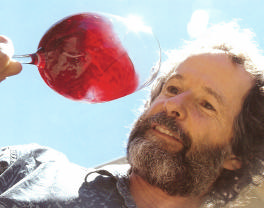 Renaissance Vineyard & Winery Gideon Bienstock has been the winemaker here since 1994 and he has been responsible for bringing refinement and elegance to Renaissance wines. Production has been downsized and focus has turned to expressing the multitude of unique Renaissance terroirs. Gideon notes, “You can taste the remarkable difference from various parts of our vineyard. Over many years of experimentation, we have learned to match every grape variety to the right microclimate, exposure, and soil combination and we maximize these differences by our organic viticulture and by vinifying separate lots individually.” Noted wine writer Matt Kramer (New California Wine) has called Renaissance “one of the most unusual and exciting wineries in California.” James Halliday (Wine Atlas of California) claimed, “If there is a more remarkable vineyard in California, I did not see it.” Renaissance was created by The Fellowship of Friends in the 1980s, and its founding winemaker was Karl Werner, formerly of Schloss Vollrads in the Rheingau. There are currently 60 acres of vineyards on steep, terraced slopes, all drip irrigated. Production is about 3,500 cases. The winery has had most success with Cabernet Sauvignon and it is the flagship wine of the Renaissance label, but there have been notable examples of Rhone varietals such as Viognier, Roussanne, Syrah, Grenache and Mourvedre. I have never sampled the Pinot Noir from Renaissance and I have not visited, but I understand the tranquility and charm of the estate is unmatched in California. There are antique fountains, a famous rose garden, a French Potager kitchen garden and olive trees from which award-winning Apollo Olive Oil is produced. Renaissance is a 75 minute drive from Sacramento, located on E21 off Hwy 20 east of Marysville at12587 Rices Crossing Road, Oregon House, CA. 800-655-3277. The website is www.rvw.com.
Ramey SchultenRamey Schulten is essentially a spinoff of Renaissance, much like Clos Saron. It is a partnership between Grant Ramey and Edward Schulten that dates back to the early 1980s Ramey is a Yuba City native and the vineyard manager for Renaissance. He has been instrumental in rehabilitating and downscaling the vast vineyards at Renaissance, directing the removal of many vines that he planted between 1976 and 1982. Schulten is a native of the Netherlands who studied winemaking at the University of Bordeaux and worked in the vineyards of France. Together they produce about 700 cases of multiple varietals in small lots including Cabernet Sauvignon, Grenache, Merlot, Syrah, Zinfandel, Sangiovese, Cabernet Franc, Pinot Noir, and even Port. They lease a portion of the Renaissance vineyard for their wines. In a few years they plan to change the name of their label to “Grant and Eddie.” Photo shows Grant (left), Marie Ramey, and Edward (right). 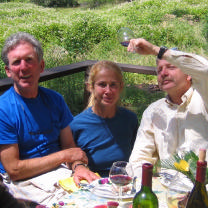
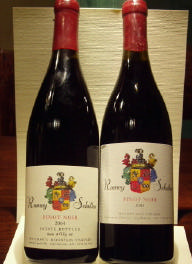 2004 Ramey Schulten Sierra Foothills Pinot Noir 13.0% alc., 25 cases, $18. Current release. · A big shouldered wine featuring robust dark Pinot extract and earth-based flavors. Very attractive nose of wood spice, ripe black raspberries and tea. Substantial tannins. Much preferred over the 2003 vintage.
2003 Ramey Schulten Sierra Foothills Pinot Noir 13% alc., $18. · Dark ruby in color. Muscular and earthy with plenty of oak influence from start to finish. Iodine and truffles are complimentary. The fruit is subdued at present. Plenty of unresolved tannins on the finish.
Ramey Schulten wines are sold primarily to restaurants and local retail stores. They are available online direct from the winery at www.rameyschulten.com. Tours and tastings are by appointment by contacting Grant at 530-692-1084.
Pinot BriefsBottle Shock, The Movie The Sundance Film Festival, which runs from January 17 through January 27, 2008, in Park City, Utah, has chosen Bottle Shock to be shown in the American Spectrum category. The movie is based on the story of Chateau Montelena, the Napa winery that took top prize in the Judgment of Paris blind wine tasting competition in 1976. Owners Jim and Bo Barrett are featured in the film. The film was produced by Brenda and Mark Lhormer, residents of Sonoma and members of the Sonoma Valley Film Society. The original script by Ross Schwartz was rewritten and brought to the screen by the Hollywood directing and producing team of Randy Miller and Jodi Savin. Filming was at various locations in Sonoma which was made to look like Paris in the 1970s. Parker vs Robinson On November 10, 2007, the Women in Wine symposium was held at Copia in the Napa Valley. According to the Napa Valley Register, keynote speaker Elizabeth Thach, Ph.D., said “We are the power base when it comes to wine purchasing.” She presented data showing that women buy 80% of the wine sold in the United States and women tend to have more discriminating palates than men. She also pointed out that women in general have more taste buds and that might explain why the two top wine critics in the world, Robert Parker, Jr., and Jancis Robinson, are often at odds with each other. I am not sure about the 80% figure, as I would say 75% of my subscribers are men and when I visit wine shops, at least 95% of the people in the store including employees and buyers are men. I can’t argue with the discriminating palate superiority, however. Pali Releases 2006 vintage Pali wine Company’s lineup of vineyard-designate Pinot Noirs reads like a who’s-who of California’s and Oregon’s distinguished vineyards. Production varies from 149 to 679 cases and includes Fiddlestix Vineyard (Sta. Rita Hills), Turner Vineyard (Sta. Rita Hills), Momtazi Vineyard (Willamette Valley), Cargasacchi-Jalama Vineyard (Santa Barbara), Shea Vineyard (Willamette Valley), Inman Olivet Grange Vineyard (Russian River Valley), and Keefer Ranch Vineyard (Russian River Valley). The wines are priced at $48. The website is www.paliwineco.com. California Pinot from Owen Roe David O’Reilly is the winemaker for Oregon’s Owen Roe Winery and one of the few native Irishmen making wine in the United States. There have been a number of California winemakers crafting wine from Oregon grapes (Fiddlehead, Siduri, Pali), but other than Patricia Green, David O’Reilly is the only Oregonian I know going the other way. His 2006 Owen Roe Santa Maria Valley Pinot Noir ($42) is sourced from the Bien Nacido Vineyard. Available at www.StorytellerWine.com. Argentine Pinot Noir Crafted by Italian Piero Incisa della Rocchetta is making artisan Pinot Noir in Argentina at his winery, Bodega Chacra, located in Argentina’s Patagonia region. The Pinot Noir vines in the Trienta y Dos vineyard were planted on their own rootstock in 1932 and had been largely neglected until he discovered them in 2002. The vines at Cincuentsa y Cinco a vineyard adjacent to Trienta y Dos, were planted in 1955. Farming here has been a challenge. Obtaining water and electricity has been difficult and in 2004, birds ate 90% of the crop (slingshots have proven to deter the birds since). The two 2006 releases are Bodega Chacra Pinot Noir Rio Negro Treinta y Dos ($120) and Bodega Chacra Pinot Noir Negro Cincuenta y Cinco ($100). 406 cases total produced. The wines are imported by the Kobrand Corporation. 
Where Are Scores in the PinotFile?Robert Parker’s 100 point wine scoring system, which became popular in 1983 and adopted by the Wine Advocate in 1988, has been a honing beacon for consumers seeking to buy good wine. Currently, a majority of United States based wine critics and magazines use the 100 point scale. The reality is that the 100 point scale is actually a 10 point scale. A score of 85 usually means a wine no one wants to buy or drink (although it is considered “good” in the 100 point scoring system). Wines scored between 85 and 89 may be perfect in the context of a good meal, yet most consumers look to wines scored 90 or above as being most desirable. There is no point in rating wines below 85 because no one cares, or greater than 95 because only the most well-healed can afford these wines. But perhaps the biggest criticism leveled at the 100 point scoring system is that it is based on the assumption that there is a detectable and measurable difference between say, a rating of 89, and 90. It is simply impossible to be that precise in judging wine. In reality, scoring a wine only matters to the person doing the scoring since we all have different tastes. It is unfortunate that wine drinkers have become so dependent on someone else telling them what they like. Patrick Mott, writing in Inside OC, put it very well, “I’ve read books, I’ve gone to wine dinners and lectures, and God knows I’ve hung out with people from time to time who know more about wine - and are eagerly willing to tell you so - than anyone in his right mind wants to know, and it all comes down to the same result: my ears start to bleed, a high-pitched humming increases in volume, and the next thing I know people are standing over me trying to cut off my clothes.” Amen - that is why you will never find any rating scores in the PinotFile.
Last Page Cartoon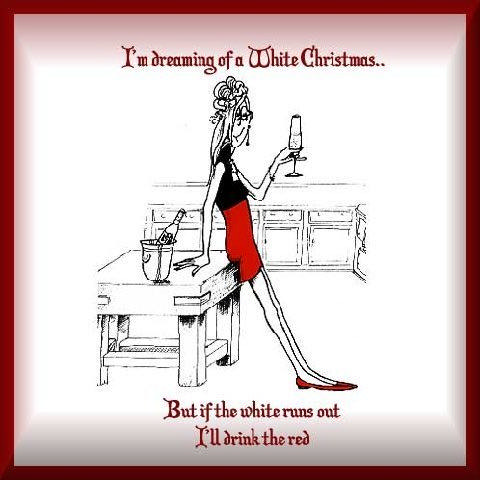 |